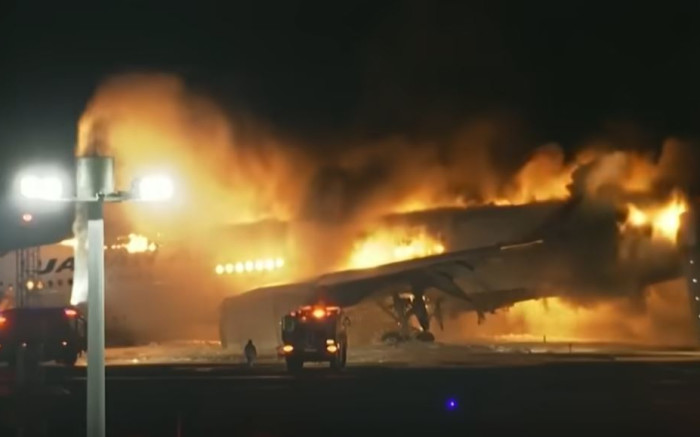
All but one of the six people aboard the smaller plane died, but all 379 Japan Airlines passengers and crew escaped via emergency slides minutes before the Airbus burst into flames late Tuesday.
TOKYO – Japanese investigators were probing a near-disastrous collision between a coast guard plane and a passenger plane at Tokyo’s Haneda airport on Wednesday that left five people dead while nearly 400 others narrowly escaped a raging inferno.
All but one of the six people aboard the smaller plane died, but all 379 Japan Airlines passengers and crew escaped via emergency slides minutes before the Airbus burst into flames late Tuesday.
The blackened shell of the airliner, still on the tarmac on Wednesday, was a testament to how dangerous their escape had been. Several hundred meters away lay the remains of the Coast Guard’s DHC-8 aircraft.
The captain of the Coast Guard plane that flew into the earthquake zone in central Japan on New Year’s Day was the sole survivor but suffered serious injuries.
Footage on Tuesday showed a fireball erupting from under the plane shortly after landing and coming to rest on its nose after the front landing gear failed.
As people scrambled to safety, dozens of fire engines with flashing blue and red lights doused the flames, but soon the entire fuselage was engulfed in flames. It took eight hours until the fire was finally extinguished.
“It got hot on the plane and to be honest I thought I wouldn’t survive,” one passenger told broadcaster NHK.
“I thought we landed normally. But then I realized I smelled smoke,” a woman with a small child told NHK.
“I had to protect my daughter. That was the only thing on my mind,” she added.
Another passenger called surviving the crash a “miracle.”
“When I landed, the impact caused me to bounce off my seat,” the 28-year-old told Nikkei Asia.
“We made it just in time. It’s a miracle we survived.”
- landing clearance –
Takuya Fujiwara of the Japan Transport Safety Board told reporters that the coast guard plane’s flight recorder and voice recorder had been found, but that the passenger plane’s recorder was still being sought.
“We are investigating the situation. Various pieces are scattered on the runway,” Fujiwara said, adding that the agency plans to question several people involved.
Asked at a briefing whether the Japan Airlines flight had permission to land, officials from the major airline said: “It is our understanding that it has been granted.”
However, JAL and the land ministry declined to comment directly on the exchange between air traffic controllers and the two planes, citing the ongoing investigation.
In a recording from Haneda’s control tower, apparently taken shortly before the collision and available on a website that broadcasts live air traffic signals, a voice can be heard instructing JAL’s flight to “continue approach.”
NHK reported that the control tower had ordered the Coast Guard plane to stay short of the runway.
The broadcaster also quoted an unnamed coast guard official as saying that the pilot, Genki Miyamoto, 39, declared immediately after the accident that he had permission to take off.
- Airbus investigators –
Dozens of domestic flights from Haneda, one of the world’s busiest airports, were canceled on Wednesday, but international arrivals and departures were little affected.
Airbus said it would send a team of specialists to help with the investigation.
The passenger plane had arrived from New Chitose Airport and was flying to Sapporo on the northern island of Hokkaido. There were eight children on board.
Prime Minister Fumio Kishida praised the deceased crew members as they moved to help victims of the quake that killed at least 62 people.
“These were employees who had a high sense of mission and responsibility for the affected areas,” he said on Tuesday.
In 1985, a JAL jumbo jet crashed while flying from Tokyo to Osaka, killing 520 passengers and crew. This was one of the world’s deadliest single-flight accidents.
The world’s worst civil aviation disaster also occurred on the ground when two Boeing 747s collided at Los Rodeos Airport in Tenerife in 1977, killing 583 people.
“I can’t speculate about what happened here, but human error is likely to be the cause,” Doug Drury, an aviation expert at Central Queensland University, told AFP.
“Airlines must be able to clear an aircraft of all passengers and crew within 90 seconds. The flight crews train quite frequently in simulations for events, and it is a complicated process that, as we have seen, has been completed without errors,” he said.
“A crucial factor was that no one tried to access his hand luggage.”






Recent Comments